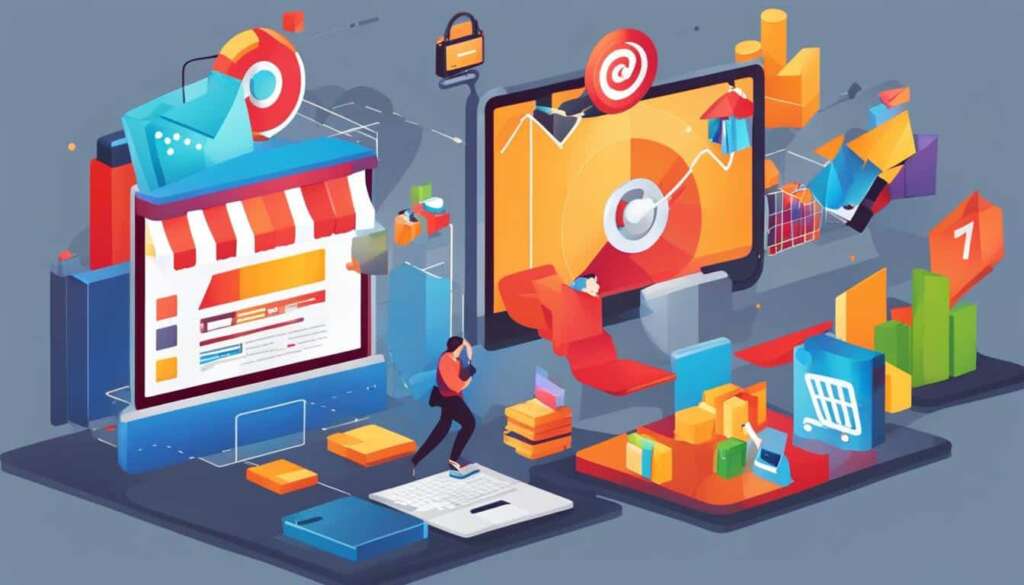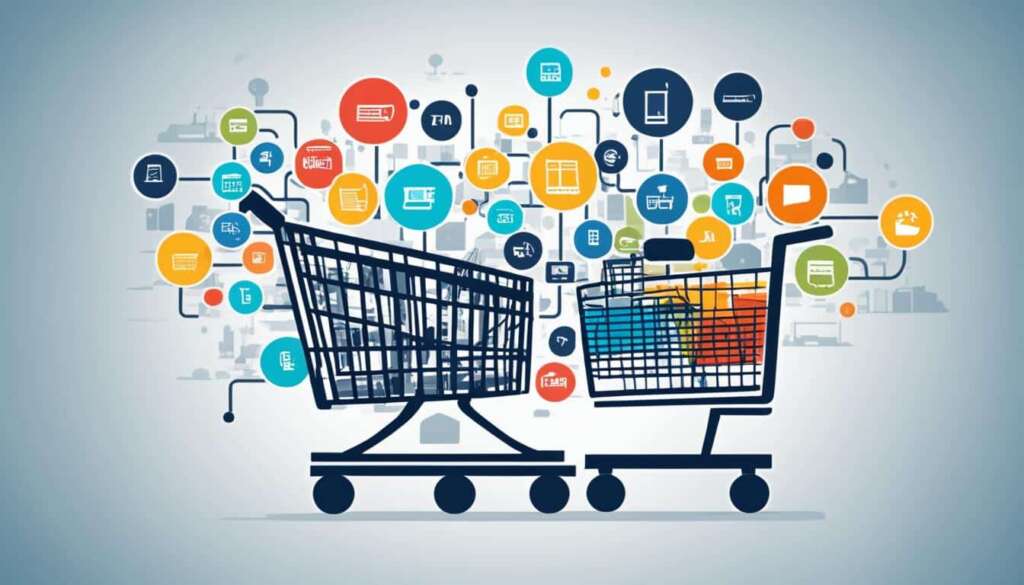Table of Contents
In today’s digital age, e-commerce has become a powerhouse in the world of retail. With the growth of online shopping and the increasing competition in the e-commerce platform, digital marketing has become vital for online businesses to succeed. In this comprehensive guide, we will explore the importance of digital marketing for e-commerce, the features of e-commerce digital marketing, and the advantages of e-commerce.
Understanding the Importance of Digital Marketing for E-commerce
Digital marketing is a critical component in the success of e-commerce businesses. With the increasing prevalence of online shopping, it has become essential for companies to leverage digital marketing strategies to maximize their reach and drive sales.
One of the key advantages of digital marketing for e-commerce is its ability to break geographical barriers and enable businesses to reach a global audience. Unlike traditional advertising methods that are limited to specific regions or target demographics, digital marketing allows businesses to expand their reach and connect with potential customers from around the world.
Moreover, digital marketing is highly cost-effective compared to conventional advertising channels. With digital marketing, businesses can allocate their budgets more efficiently and achieve greater returns on investment. By targeting specific customer segments and utilizing data-driven insights, e-commerce brands can optimize their marketing efforts and reduce wasteful spending.
“Digital marketing allows e-commerce businesses to precisely target their ideal customers, increasing conversion rates.”
Another crucial aspect of digital marketing for e-commerce is its measurability. Unlike traditional marketing methods that are challenging to track and measure accurately, digital marketing provides real-time data and analytics. Businesses can monitor the performance of their campaigns, track website traffic, and measure the effectiveness of their marketing strategies. This data-driven approach enables businesses to make data-backed decisions, refine their marketing strategies, and improve their overall performance.
Furthermore, digital marketing offers targeted marketing capabilities, allowing businesses to tailor their marketing messages to specific customer segments. By leveraging customer data, businesses can create personalized and relevant marketing campaigns that resonate with their target audience. This targeted approach enhances customer engagement, increases brand loyalty, and ultimately drives higher conversion rates.
Benefits of Digital Marketing for E-commerce:
- Global reach, breaking geographical barriers
- Cost-effectiveness and efficient budget allocation
- Real-time tracking and measurement of campaign effectiveness
- Precise targeting of ideal customers
- Enhanced customer engagement and higher conversion rates
Overall, digital marketing is an indispensable tool for e-commerce businesses looking to thrive in the digital landscape. Its reach, cost-effectiveness, measurability, and targeting capabilities provide a competitive edge in the highly competitive online marketplace.
Features of E-commerce Digital Marketing
E-commerce digital marketing encompasses various features and strategies tailored to drive online sales and enhance the online shopping experience. Understanding and implementing these features is crucial for the success of any e-commerce business. Let’s explore some key components involved in e-commerce digital marketing:
1. Search Engine Optimization (SEO)
Search engine optimization (SEO) plays a vital role in improving website visibility and driving organic traffic. By optimizing website content, structure, and technical aspects, businesses can rank higher in search engine results, ensuring maximum visibility to potential customers.
2. Keyword Research
Keyword research is a fundamental aspect of digital marketing for e-commerce. By identifying relevant keywords related to the products or services offered, businesses can optimize their content strategy, website structure, and advertising campaigns, increasing the chances of reaching their target audience.
3. Content Marketing
Content marketing involves creating and distributing valuable, relevant, and consistent content to attract and educate customers. By providing informative and engaging content through blog posts, videos, infographics, and other formats, businesses can establish themselves as industry experts and build trust with their audience.
4. Social Media Marketing
Social media marketing is an essential tool for promoting products, engaging with customers, and building brand awareness. By leveraging popular social media platforms such as Facebook, Instagram, Twitter, and LinkedIn, e-commerce businesses can reach a broader audience, drive traffic to their website, and foster customer loyalty.
5. Email Marketing
Email marketing is a powerful tool for nurturing customer relationships and driving repeat purchases. By building an email list and delivering targeted and personalized content, businesses can keep customers informed about new products, promotions, and updates, ultimately driving conversions and maximizing customer lifetime value.
6. Pay-Per-Click (PPC) Advertising
PPC advertising involves running paid ads on search engines and social media platforms, allowing businesses to reach their target audience efficiently. By bidding on relevant keywords and targeting specific demographics, businesses can drive immediate traffic to their website and boost sales.
7. Shopping Ads
Shopping ads provide a visual representation of products in search results, attracting potential customers and driving them to the e-commerce website. These ads typically include product images, prices, and brief descriptions, making them highly effective in generating qualified leads and increasing conversion rates.
8. Remarketing
Remarketing involves targeting users who have previously visited the website or shown interest in specific products. By displaying personalized ads to these potential customers across various platforms, businesses can re-engage them and increase the chances of conversion.
9. Conversion Rate Optimization (CRO)
CRO focuses on enhancing website design and user experience to maximize conversions. By analyzing user behavior, conducting A/B testing, and optimizing landing pages and checkout processes, businesses can reduce friction, increase customer satisfaction, and improve their overall conversion rates.
10. Influencer Marketing
Influencer marketing involves collaborating with influential individuals or popular personalities to promote products or services. By leveraging the reach and credibility of influencers, businesses can tap into new audiences, increase brand visibility, and drive conversions.
11. Affiliate Marketing
Affiliate marketing allows businesses to partner with other websites or influencers who promote their products in exchange for a commission. This strategy leverages the affiliate’s audience and credibility, expanding the business’s reach and driving sales.
12. Analytics
Analytics plays a crucial role in measuring the success of e-commerce digital marketing efforts. By tracking key metrics such as website traffic, conversions, and customer behavior, businesses can gain valuable insights and make data-driven decisions to optimize their marketing strategies for optimal results.
Implementing these features and strategies can help e-commerce businesses establish a strong online presence, increase brand awareness, drive targeted traffic, and ultimately boost sales. Embracing the power of e-commerce digital marketing is essential in today’s competitive landscape.
Types of E-commerce
When it comes to e-commerce, there is a diverse range of business models that cater to different types of transactions. Let’s explore some of the most common types of e-commerce:
B2C (Business-to-Consumer)
In the B2C model, businesses sell products directly to individual consumers. This is the traditional online retail model, where customers browse and purchase products from e-commerce websites. Well-known examples of B2C e-commerce platforms include Amazon, eBay, and ASOS.
B2B (Business-to-Business)
B2B e-commerce involves businesses selling products or services to other businesses. This model is typically characterized by larger order quantities and long-term business relationships. Popular B2B e-commerce platforms are Alibaba, Thomasnet, and Uline.
C2C (Consumer-to-Consumer)
In the C2C model, individuals sell products directly to other consumers. Online marketplaces facilitate these transactions, allowing individuals to list and sell their used or new products to interested buyers. Some popular C2C e-commerce platforms include eBay (for auction-style listings) and Depop (for fashion resale).
C2B (Consumer-to-Business)
C2B e-commerce refers to scenarios where consumers offer products or services to businesses. This model is commonly seen in the gig economy, where individuals offer their skills or expertise to businesses on a freelance or contract basis. Platforms like Upwork and Fiverr enable C2B transactions.
D2C (Direct-to-Consumer)
D2C e-commerce involves brands selling their products directly to consumers, bypassing traditional retail channels. By cutting out intermediaries, brands can maintain greater control over the customer experience and build direct relationships. Examples of successful D2C brands include Warby Parker and Glossier.
M-Commerce (Mobile Commerce)
M-Commerce refers to transactions conducted through mobile devices, such as smartphones and tablets. With the increasing use of mobile devices, businesses have optimized their websites and developed mobile apps to cater to on-the-go shoppers. Popular M-Commerce platforms include mobile apps for Amazon, eBay, and Shopify.
Dropshipping
Dropshipping is an e-commerce fulfillment model where retailers partner with suppliers to fulfill customer orders. Instead of holding inventory, the retailer transfers customer orders and shipment details to the supplier, who then directly ships the products to the customers. This allows retailers to offer a wide range of products without the need for inventory management. Shopify and Oberlo are popular platforms used for dropshipping.
Understanding the different types of e-commerce models is crucial for businesses aiming to establish an effective online presence. By choosing the right model and utilizing the appropriate digital marketing strategies, businesses can tap into the vast potential of e-commerce and drive success.

Conclusion
In the fast-paced world of e-commerce, businesses must implement proven strategies to stay ahead of the competition. This requires optimizing the online shopping experience, leveraging digital marketing channels, adopting a customer-centric approach, streamlining fulfillment processes, and harnessing the power of data analytics. By embracing these strategies, businesses can position themselves for sustained e-commerce growth and success in the ever-evolving digital landscape.
One key aspect of e-commerce growth is optimizing the online shopping experience. This involves designing user-friendly websites, providing seamless navigation, and ensuring secure and efficient checkout processes. By creating a smooth and user-friendly interface, businesses can enhance customer satisfaction and increase conversion rates.
Furthermore, adopting a customer-centric approach is essential for e-commerce success. Understanding customer needs, preferences, and pain points allows businesses to tailor their marketing strategies and offerings accordingly. By placing the customer at the center of their operations, businesses can build stronger relationships, foster loyalty, and drive repeat purchases.
Data analytics plays a crucial role in e-commerce growth. By leveraging data, businesses can gain valuable insights into customer behavior, purchase patterns, and market trends. This enables them to make data-driven decisions, optimize marketing campaigns, and personalize the customer experience. With the right analytics tools and a deep understanding of the data, businesses can identify opportunities for growth and stay ahead of the competition.
FAQ
What is e-commerce marketing?
E-commerce marketing refers to the strategies and techniques used to promote and sell products or services online through digital channels.
Why is digital marketing important for e-commerce?
Digital marketing is important for e-commerce because it allows businesses to reach a global audience, provides cost-effective advertising options, offers real-time tracking and measurement of campaign effectiveness, and enables precise targeting of ideal customers.
What are the features of e-commerce digital marketing?
The features of e-commerce digital marketing include search engine optimization (SEO), keyword research, content marketing, social media marketing, email marketing, PPC advertising, shopping ads, remarketing, conversion rate optimization (CRO), influencer marketing, affiliate marketing, and analytics.
What are the different types of e-commerce?
The different types of e-commerce include B2C (business-to-consumer), B2B (business-to-business), C2C (consumer-to-consumer), C2B (consumer-to-business), D2C (direct-to-consumer), M-Commerce (mobile commerce), and dropshipping.













